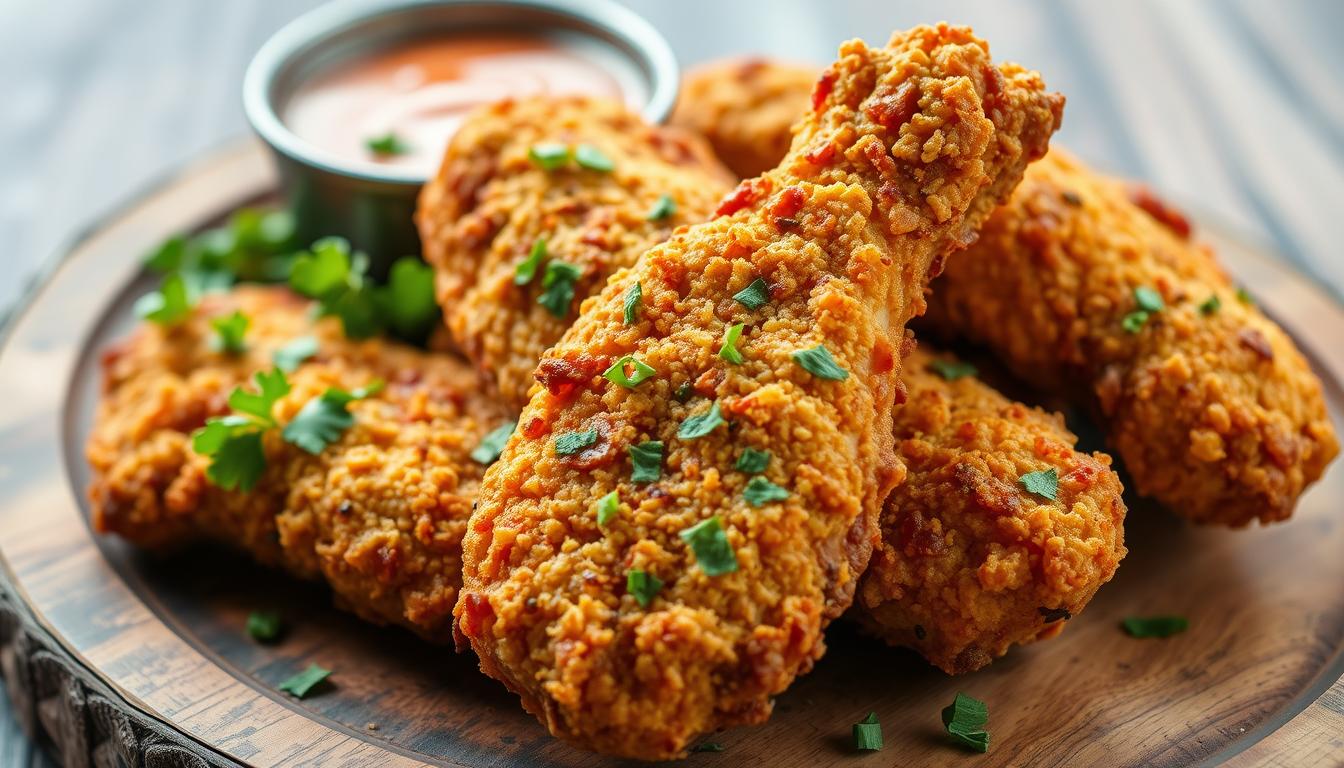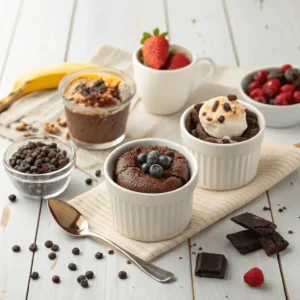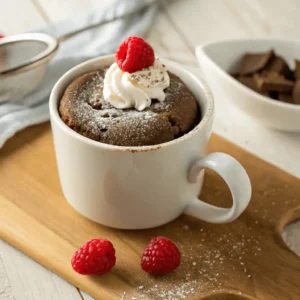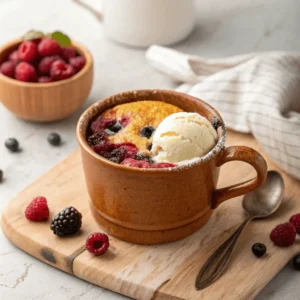Get ready to excite your taste buds with homemade spicy chicken tenders that match top restaurant quality. Learn the secret to a perfect mix of heat and crunch. This guide will help you make restaurant-quality spicy chicken tenders at home.

Key Takeaways
- Uncover the essential ingredients for flavorful and crispy chicken tenders
- Master the techniques for achieving the perfect crunch, including temperature control and oil selection
- Discover the secrets to crafting the ultimate marinade for juicy and tender chicken
- Learn the art of breading for maximum crispiness and flavor
- Explore the versatility of spice blends to customize the heat level and regional flavors
Why These Spicy Chicken Tenders Will Become Your New Favorite
Get ready for a thrilling taste adventure with our spicy chicken tenders. These delicious strips mix fiery heat with tasty flavor. They’re a game-changer in chicken tenderloin dishes.
The Perfect Balance of Heat and Flavor
Our spicy chicken tenders’ secret is in the premium spices we use. We’ve made a special seasoning that adds a nice kick without losing the chicken’s juiciness. Each bite is a mix of flavors that will make you want more.
Health Benefits of Spicy Foods
Spicy foods are good for you, not just tasty. Chili peppers contain capsaicin, which boosts metabolism and fights inflammation. Eating our spicy chicken tenders is good for your body and taste buds.
Try our spicy chicken tenders for a better dining experience. Enjoy the perfect mix of heat and flavor. Plus, you’ll get the health perks of spicy foods.
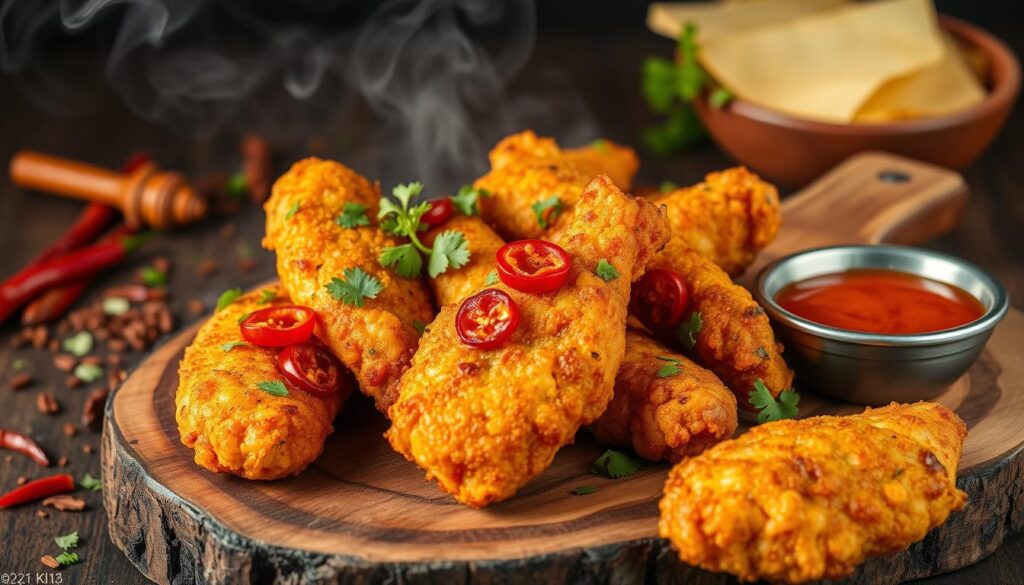
Essential Ingredients for Restaurant-Quality Chicken Tenders
To make your chicken tender recipes taste like they’re from a restaurant, start with the right ingredients. Choose the best chicken tenderloin dishes and add the perfect spices and breadcrumbs. This guide will help you make your tenders both flavorful and authentic.
Begin with top-notch chicken tenderloins. These lean cuts are perfect for making tender, small pieces of chicken. Then, pick a breading mix that includes seasoned breadcrumbs, panko, and spices. This mix adds texture and taste to your tenders.
| Ingredient | Purpose |
|---|---|
| Chicken Tenderloins | Provides the perfect base for tender, juicy chicken tenders |
| Seasoned Breadcrumbs | Adds a crunchy, flavorful coating |
| Panko Breadcrumbs | Enhances the overall crispiness of the tenders |
| Spices (e.g., paprika, garlic powder, onion powder) | Elevates the flavor profile with a blend of savory, aromatic notes |
By choosing these key ingredients, you can make your homemade chicken tender recipes and chicken tenderloin dishes taste like they’re from a restaurant.
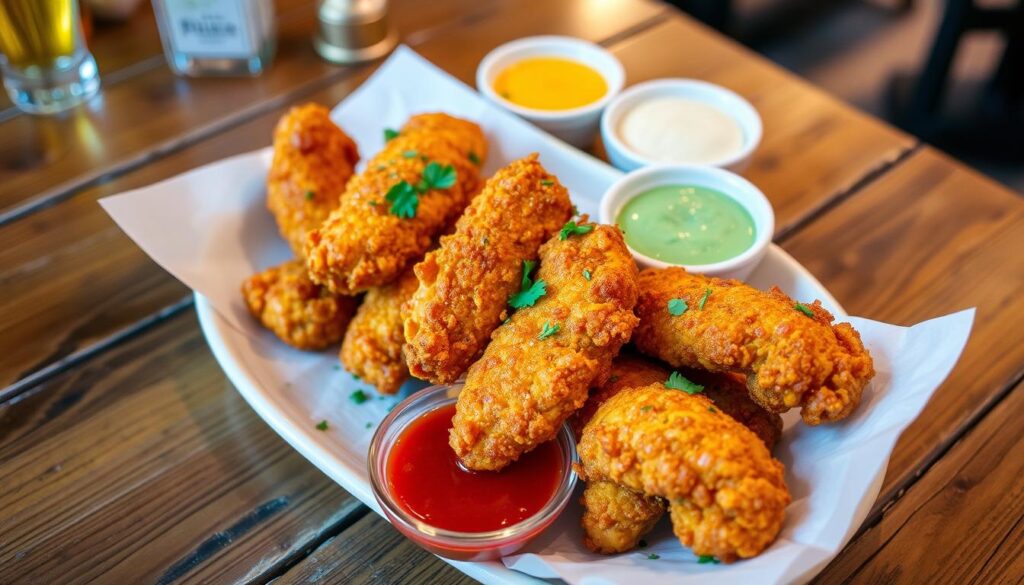
The Secret to Achieving Ultimate Crispiness
Getting your crispy chicken tenders or fried chicken tenders just right is a challenge. But, with the right methods, you can nail that crispy texture every time. This includes the double-coating method, controlling the temperature, and picking the right oil.
Double-Coating Technique
The double-coating method is key to crispy crispy chicken tenders. First, you coat the chicken lightly. Then, you add a thicker layer of breading. This traps moisture inside while making the outside crispy. This two-step process ensures your tenders stay crunchy, no matter how you cook them.
Temperature Control Tips
Temperature is vital for crispiness. Keep the oil between 350°F and 375°F for a golden, crunchy exterior. If the oil is too cool, the chicken will soak up too much oil, making it greasy. On the other hand, too hot oil can burn the outside before the inside is cooked.
Oil Selection Guide
| Oil Type | Smoke Point | Flavor | Recommended for Frying |
|---|---|---|---|
| Vegetable Oil | 400-450°F | Neutral | Yes |
| Peanut Oil | 450°F | Mild, nutty | Yes |
| Canola Oil | 400-450°F | Mild, slightly sweet | Yes |
| Olive Oil | 375-400°F | Robust, fruity | No |
Choosing the right oil is essential for crispiness. Use oils like vegetable, peanut, or canola oil. They have a high smoke point and a neutral flavor that won’t overpower your crispy chicken tenders.
Mastering the Perfect Marinade
Making the perfect marinade is like an art form. It can make your spicy chicken tender experience even better. The trick is to find the right mix of flavors that make your chicken strips taste amazing and tender.
To make a marinade that’s as good as restaurant chicken tenders, start with a tasty mix. Use tangy buttermilk or yogurt as the base. It helps keep the meat moist and tender. Then, add spices, herbs, and aromatics to give it depth and complexity.
- Buttermilk or plain yogurt
- Garlic, minced
- Fresh herbs (such as thyme, rosemary, or parsley)
- Spices (such as paprika, chili powder, or cayenne)
- Lemon or lime juice
- Salt and black pepper
Let your chicken tenders soak in this flavorful marinade for at least 30 minutes. For even better tenderness and juiciness, marinate them for up to 8 hours. Always keep the chicken refrigerated during marinating to stay safe.
| Marinating Time | Tenderness and Flavor Impact |
|---|---|
| 30 minutes | Moderate tenderness and flavor infusion |
| 2-4 hours | Improved tenderness and deeper flavor penetration |
| 6-8 hours | Exceptionally tender and flavorful chicken tenders |
With a little practice in marinating, your spicy chicken strips will be a hit. They’ll come out of the fryer or oven full of flavor and tender texture.
Breading Techniques for Extra Crunch
Getting your chicken tenders crispy is an art. The secret is in the breading technique. Learn these methods to get maximum crunch and flavor.
Wet Hand, Dry Hand Method
The wet hand, dry hand method is a game-changer for breading chicken tenders. It makes sure your coating is even and mess-free. Here’s how to do it:
- Set up your breading station with three shallow dishes. One for flour, one for beaten eggs, and one for seasoned breadcrumbs.
- Use your wet hand to dip the chicken tenders in the egg mixture. Make sure to let any extra drip off.
- Switch to your dry hand to coat the tenders in breadcrumb mixture. Press gently to make sure it sticks.
- Do this for each tender. Keep one hand for wet ingredients and the other for dry.
Seasoning Your Breadcrumbs
Make your crispy chicken tenders even better by seasoning your breadcrumbs. This adds a burst of flavor. Try using:
- Garlic powder
- Onion powder
- Paprika
- Cayenne pepper
- Dried herbs (such as thyme, oregano, or parsley)
Just toss the breadcrumbs with your chosen seasonings and mix well. This will make your chicken tender recipe even more flavorful and textured.
Frying vs. Baking: Choose Your Method
Choosing between fried chicken tenders and baked chicken tenders can change how your dish tastes. Both methods have their own benefits. It all depends on what you like and what’s good for you.
If you want that crispy, golden-brown outside, frying is your best bet. The hot oil makes the outside crunchy while keeping the inside juicy. But, you must watch the oil temperature closely to avoid greasy tenders.
Baking chicken tenders is a healthier choice that can still be crispy. Using a hot oven and special techniques like double-coating can give you a crispy texture without extra fat. Plus, baking is easier because it doesn’t need as much attention.
| Frying | Baking |
|---|---|
| Achieves classic crispy exterior | Healthier cooking method |
| Requires careful temperature control | Convenient, hands-off cooking |
| Higher in calories and fat | Can still achieve crisp texture |
So, whether you prefer fried chicken tenders or baked chicken tenders, it’s up to you. Try both to find the perfect mix of crunch and juiciness that you love.
Signature Spice Blend for Maximum Heat
Take your spicy chicken tenders to the next level with a special spice blend. Making your own blend is key to making your spicy chicken tenders unique. By picking and mixing spices, you can get the perfect mix of heat and flavor. This will make your guests want more.
Customizing Heat Levels
Everyone likes different levels of spice. Some want it very hot, while others prefer a little kick. A homemade spice blend lets you adjust the heat to your liking. Start with cayenne pepper, paprika, and black pepper. Then, add more or less to get the heat you want.
For a stronger heat, add ghost pepper or habanero powder. For a milder taste, use less cayenne and add garlic and onion powder.
Regional Spice Variations
- Cajun-Inspired Blend: Mix smoked paprika, dried thyme, and a bit of cayenne for a Bayou twist on your spicy chicken strips.
- Asian-Influenced Blend: Use white pepper, ginger, and five-spice powder for a taste inspired by Asia.
- Mexican-Style Blend: Combine chili powder, cumin, and oregano for a spicy, south-of-the-border flavor on your spicy chicken tenders.
Try different spice mixes to find your perfect blend. The choices are endless for making a unique spice mix for your spicy chicken tenders.
Must-Try Dipping Sauce Combinations
Take your spicy chicken tenders to the next level with tasty dipping sauces. You’ll find everything from classic tastes to unique mixes. These sauces add a cool contrast that makes your taste buds happy.
Ranch and Blue Cheese
The mix of creamy ranch and tangy blue cheese is a classic. It’s a great match for spicy chicken strips. The cool flavors balance the heat, making each bite perfect.
Honey Mustard
Honey mustard dipping sauce is sweet and zesty. It’s a perfect match for chicken tender dipping sauces. This combo is a delightful contrast that you’ll love.
Sweet Chili Sauce
For a sweet and spicy kick, try sweet chili sauce. It adds a unique flavor to spicy chicken strips. This sauce offers a satisfying taste experience.
Garlic Parmesan
Make your chicken tender dipping sauces even better with garlic Parmesan. The creamy, garlicky sauce pairs well with crispy tenders. It’s a delicious combo that will leave you wanting more.
Try out these and other dipping sauce combos to find your favorite. The world of flavors is vast, so explore and find new favorites that will excite your taste buds!
Storage and Reheating Tips
Enjoying your homemade crispy chicken tenders doesn’t have to end when the meal is over. You can still enjoy those tasty chicken tender recipes as leftovers. Here’s how to keep them crispy and fresh.
Maintaining Crispiness
The secret to reheating crispy chicken tenders is proper storage. Here are some tips to keep them crispy:
- Let the tenders cool completely before storing.
- Put them in a single layer on a baking sheet or wire rack, then refrigerate.
- Avoid stacking or crowding the tenders, as this can lead to steaming and sogginess.
- When reheating, use the oven or an air fryer to restore the crispy texture.
Freezing Guidelines
For longer-term storage, you can freeze your crispy chicken tenders. Here’s how to freeze and thaw them successfully:
- Arrange the tenders in a single layer on a baking sheet and place in the freezer until fully frozen.
- Transfer the frozen tenders to an airtight container or resealable bag, removing as much air as possible.
- Freeze the tenders for up to 3 months.
- When ready to enjoy, thaw the tenders in the refrigerator overnight before reheating.
By following these tips, you can enjoy the delicious crispiness of your homemade crispy chicken tenders anytime. Enjoy your favorite chicken tender recipes without losing that irresistible texture.
Troubleshooting Common Issues
Making the perfect chicken tender recipes or fried chicken tenders can be tricky. But don’t worry! This section will help you solve common problems. You’ll learn how to make your chicken tenders crispy, juicy, and full of flavor every time.
Preventing Soggy Breading
Do your chicken tenders have a soggy crust? It might be because of how you’re breading them. Use the “wet hand, dry hand” method for coating. Also, make sure your frying oil is at the right temperature. And don’t forget to dry the chicken well before breading to get rid of extra moisture.
Achieving Juicy, Tender Meat
Overcooking can make chicken tenders dry and tough. To avoid this, check the chicken’s internal temperature. Take it out of the oil or oven when it hits 165°F. A good marinade can also help keep the meat moist and tasty.
Controlling Spice Levels
- If your chicken tender recipes are too spicy, try reducing the amount of cayenne or other hot spices in your seasoning blend.
- Conversely, if you’d like to increase the heat, consider adding more cayenne or experimenting with different chili powders.
- Remember, the type of hot sauce or chili you use can also impact the overall spice level.
| Common Issue | Possible Causes | Solutions |
|---|---|---|
| Soggy Breading | Improper breading technique Excess moisture on chicken Incorrect oil temperature | Use “wet hand, dry hand” method Pat chicken dry thoroughly before breading Maintain proper oil temperature |
| Dry, Tough Chicken | Overcooking Lack of marinade | Monitor internal temperature (165°F) Marinate chicken for added moisture |
| Overly Spicy Tenders | Too much cayenne or hot spices Potent hot sauce or chili powder | Reduce cayenne or hot spices in seasoning Experiment with milder spice blends |
By tackling these common issues, you’ll be on your way to making chicken tender recipes and fried chicken tenders that are just right. Remember these tips, and enjoy your homemade chicken tenders!
Conclusion
Creating crispy spicy chicken tenders at home is a fun journey. You’ve learned the key techniques and how to balance heat and flavor. Now, you can impress your family and friends with amazing dishes.
This guide has given you the tools to make perfect spicy chicken tenders. You can try different spice mixes and sauces to match your taste. It’s all about having fun and making it your own.
So, put on your apron and start cooking. Enjoy the thrill of making crispy, tasty chicken tenders. You’ll love the mix of heat and crunch in your chicken tenders. They’ll become your favorite dish.
FAQ
What makes these spicy chicken tenders so special?
These spicy chicken tenders are special because they have just the right mix of heat and flavor. They are made with a special spice blend and cooked to perfection. This makes them crispy on the outside and juicy on the inside, making you want more.
What are the health benefits of eating spicy foods?
Eating spicy foods, like these tenders, can be good for you. They might help speed up your metabolism, reduce inflammation, and even protect against free radicals. So, you can enjoy these tasty tenders without feeling guilty.
What are the key ingredients for restaurant-quality chicken tenders?
To make restaurant-quality chicken tenders at home, you need the right chicken, spices, and breadcrumbs. This guide will show you what ingredients and techniques to use.
How do I get the ultimate crispy texture on my chicken tenders?
For the perfect crispy texture, use a double-coating method and control the temperature. Also, choose the right oil for frying. This section has all the tips to get your tenders crispy every time.
How do I create the perfect marinade for my chicken tenders?
A flavorful marinade is key for juicy chicken tenders. Learn about the best ingredients, marinating times, and techniques to make your tenders extra delicious.
Should I fry or bake my chicken tenders?
Both frying and baking can make delicious crispy chicken tenders. This section compares the two methods, so you can choose what works best for you.
How can I customize the heat level in my spicy chicken tenders?
You can make your own spice blend to control the heat. This guide also talks about different spice variations to find the flavor you like best.
What are some tasty dipping sauce combinations for spicy chicken tenders?
There are many tasty dipping sauces for spicy chicken tenders. From classic to creative, you’ll find the perfect sauce to go with your homemade tenders.
How can I store and reheat my chicken tenders to maintain crispiness?
Learn how to store and reheat your chicken tenders to keep them crispy. This section has tips on keeping them fresh and guidelines for freezing and thawing.
How can I troubleshoot common issues when making chicken tenders?
If you face problems like soggy breading or dry meat, don’t worry. This section has solutions to help you make perfect chicken tenders every time.

